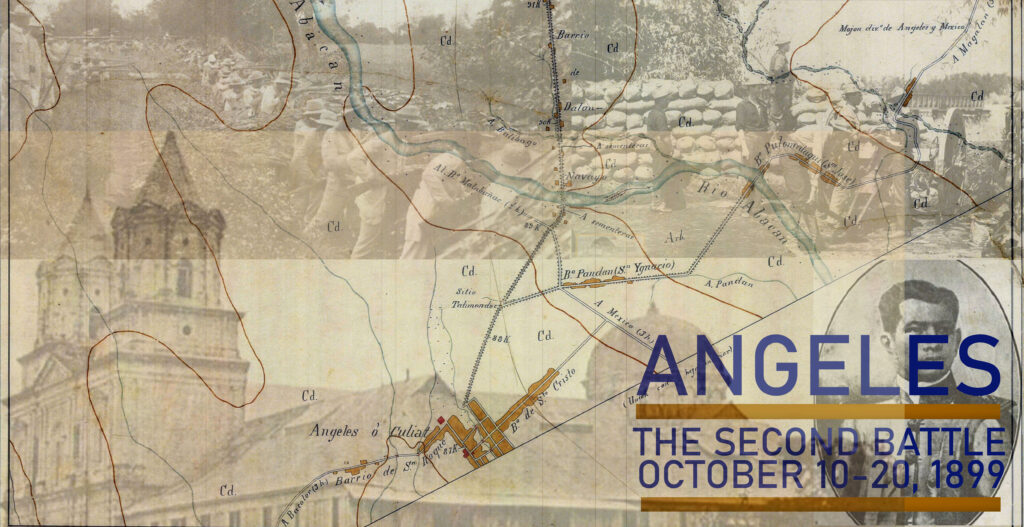
Art by Rhonie Dela Cruz
Investigating History: The Forgotten Conflicts Of The Philippine-American War
THE SECOND BATTLE OF ANGELES: FILIPINO ATTACK ON AMERICAN LINE, OCTOBER 10-20, 1899
AFTERMATH OF THE BATTLE OF PORAC
October is a month that is one of the highlights of the WWII History, the Leyte Landing and the Battle of Leyte Gulf that pave way for the start of the Liberation of the Philippine in 1945. On the other spectrum of our Nation’s military history, particularly the local scene, is the Philippine-American War 1899. It is befitting that the heroism of our forgotten Filipino soldiers shall not be forgotten, for their sacrifices and bravery they had given in the service of our country. And October is also an important one that should not be forgotten, especially in the Kapampangan region; the Battle of Angeles, second phase.

Abacan railroad bridge, overlooking north, where the San Miguel Brigade was holed
among the trenches and bamboo thickets, October 1899 (prob).
US NARA photo, courtesy of Dave Metherell.
After the battle of Porac on September 28, 1899, the Filipino forces located on the northwest Pampanga area under the command of General Tomas Mascardo retreated further into the mountains, with the combined forces of 1st and 2nd Brigade, 2nd US Division with General MacArthur personally in command at the front line on flanking movement from Sta. Rita-San Antonio and Angeles columns. General MacArthur and his two brigades went to Angeles, where he established headquarters at the Pamintuan Mansion. Angeles became the important northernmost basement of the American 2nd Division, confronting the Philippine Division line on the north banks of the Abacan River that had been in position since the fall of Angeles in August 16, 1899.

several locomotives and cars. The dry riverbanks of the Abacan became the battlefield
between Filipino soldiers from the San Miguel Brigade and the American 1st Brigade in 1899.
US NARA photo.
DISPOSITION OF FILIPINO FORCES
Filipino Forces Under General Concepcion, Early October 1899
The northern advance of General MacArthur’s division was stalled at Angeles, since the presence of Mascardo Brigade still constituted a threat to the left of the railroad line. After the first battle of Porac, the main Filipino forces constituting the Philippine Division under General Venancio Concepcion was located on the north of the Abacan River, in front of the wrecked railroad bridge confronting the American 2nd Division. In early October, the Filipino forces were at 3,000 men strong. In the succeeding days, that force increased to 4,000 under General Concepcion.
Filipino forces under General Concepcion, General in Chief of Abacan Line:
San Miguel Brigade: General Hizon, commanding; October 16, 1899, main line;
Kawit Battalion
Zambales Battalion
Lacuna Column
Aquino Brigade: Right flank;
Torres Bugallon Column: under Colonel Simon
Dayrit Column: under Major Dayrit
Mascardo Brigade: (elements) rear line, south and northwest in Porac and Angeles mountains.
Corps of Artillery, Philippine Army: under Colonel Ladislao Jose and Major Badell.
General Concepcion, at the time, had his field headquarters established at Mabalacat, in the rear of the main battle front of the railroad and wagon road.
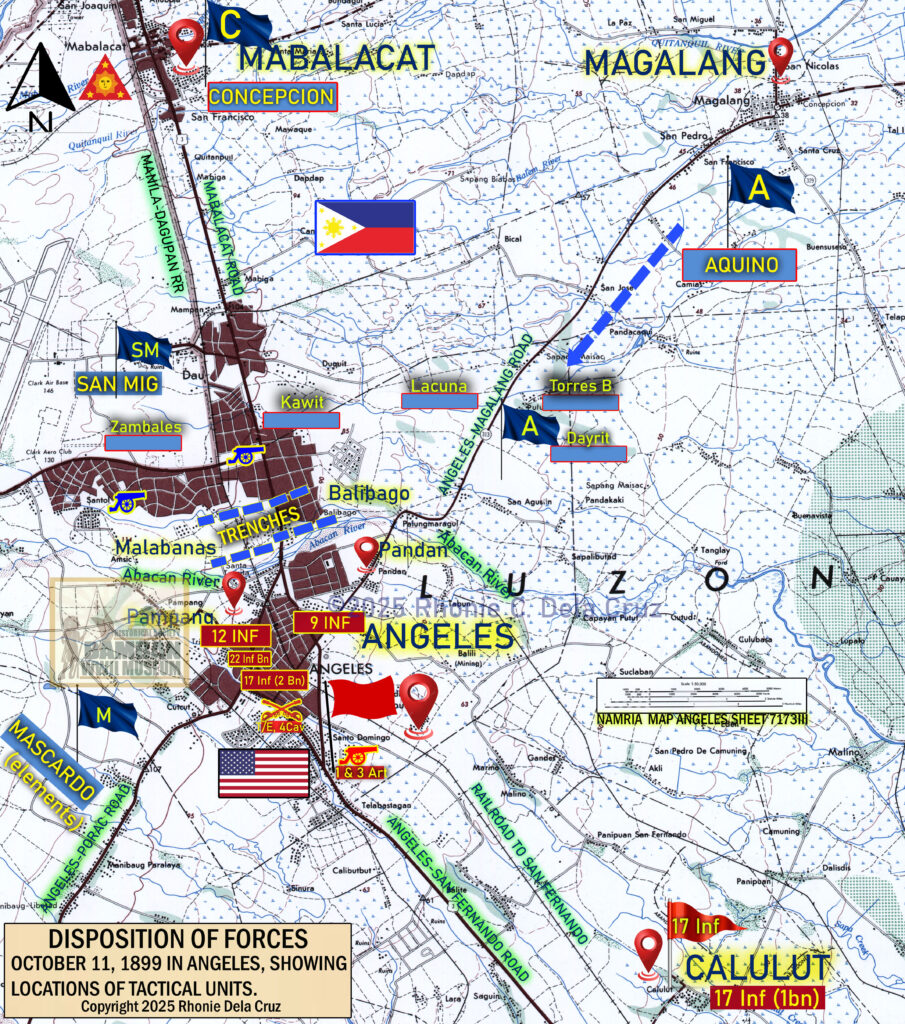
The Philippine Division at the Abacan was composed of the elements of General Hizon Brigade, Colonel Queri, the Zambales Battalion, the Kawit Battalion, company of Gapan Volunteers and the main force of General Luciano San Miguel Brigade (generally, such brigade composed of more than 1,000 men), posted near the wrecked railroad bridge. The brigade of General Aquino was located on the Arayat-Magalang line, in support of the east of the main line at Abacan while the Mascardo Brigade, located west of Angeles, and the Colonel Lacuna column will be in general support.
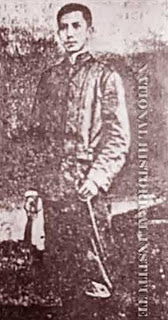
the Filipino general from
Cavite that Angelenos has
forgotten, who fought in the
defense of the town from August
to October 1899.
One of the importance of the Battle of Angeles, second phase that should be a highlight in the annals of the Philippine-American War, was the employment of modern artillery guns, especially Hotchkiss, Maxim-Nordenfeldt, Krupp, and Colt automatic gun; contrary to the usual understanding that Filipino used antiquated bronze gun like that in display of Clark Museum. The fact was that the Philippine Corps of Artillery, under Colonel Ladislao Jose, with his field commander Major Badell.
Outside the Filipino Abacan Line, there were 2 battalions (9 companies) posted at the barrio Palutput and Porac mountains under the command of General Mascardo with 537 men armed with rifles. At the area of Floridablanca, 3 companies were posted with 113 infantry and 23 cavalry troops, while the flying column of Colonel Roberto de Laea, with168 troops can be found in the vicinity. General Concepcion field headquarters were at Mabalacat, while at the time,
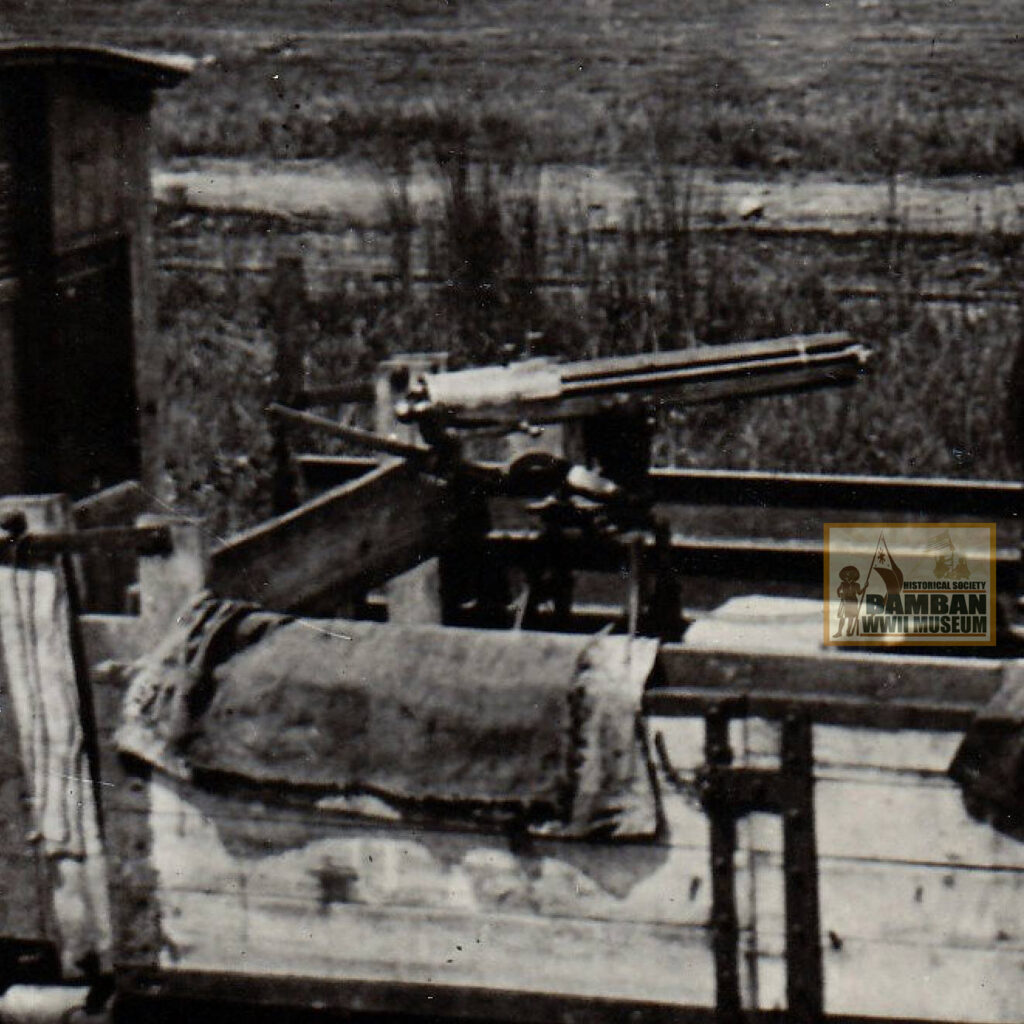
who was deployed at the Abacan railroad bridge and used against the San Miguel Brigade in
1899. The same type of revolving cannon was used by the Corps of Artillery of the
Philippine Army against the 9th US Infantry outposts in Abacan in October 1899.
AMERICAN FORCES AT ANGELES
General MacArthur’s division headquarters was established at the Pamintuan Mansion. A few meters away, the division hospital was located inside the Angeles Cathedral (Pisamban Maragul). The following comprised the command of the 2nd Division under General Arthur MacArthur in Angeles in early October 1899:
1st Brigade:
9th US Infantry: right flank
12th US Infantry: left flank)
2nd Brigade:
17th US Infantry: left of 9th US Infantry, east of Mabalacat Road and Magalang Road
36th US Infantry (Volunteers): south and southwest of Angeles.
1st US Artillery, Light Battery E
3rd US Artillery, Light Battery K
Battalion of Engineers
Company F, Signal Corps
Medical Department, 1st Brigade
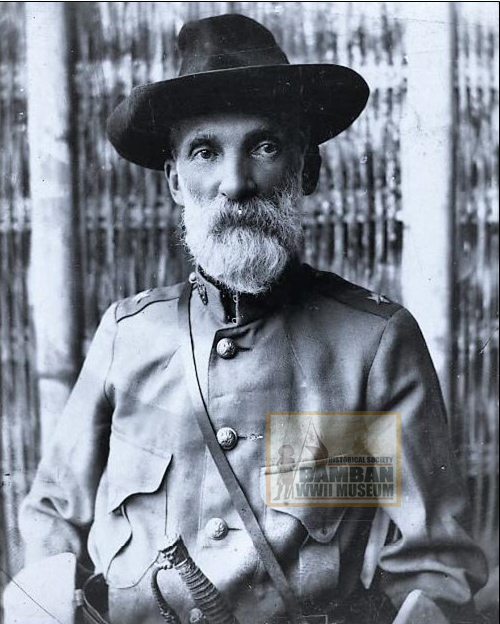
Army Corps, where the 9th and the 12th US Infantry belonged and fought
in defending the American lines at the Abacan in the Second Battle of
Angeles, October 1899.
Photo courtesy of Dave Metherell.
At Angeles, the 9th and 12th US Infantry of the 1st Brigade were the main infantry force, with elements of the 17th US Infantry with 2 battalions, Troop E and K of the 4th US Cavalry, and the artillery with the 1st and 3rd US Artillery, including Light Battery E commanded by Captain Andrews. Other non-combat units were the Battalion of Engineers under Captain W. Sibert, and Major Drake of the Medical Department for the 1st Brigade. The total strength of General MacArthur’s command at Angeles was at 3,000 effective soldiers. Outside Angeles, a battalion of the 17th US Infantry was posted at barrio Calulut, while the 36th US Infantry (Volunteers) was posted at the town of Sta. Rita.
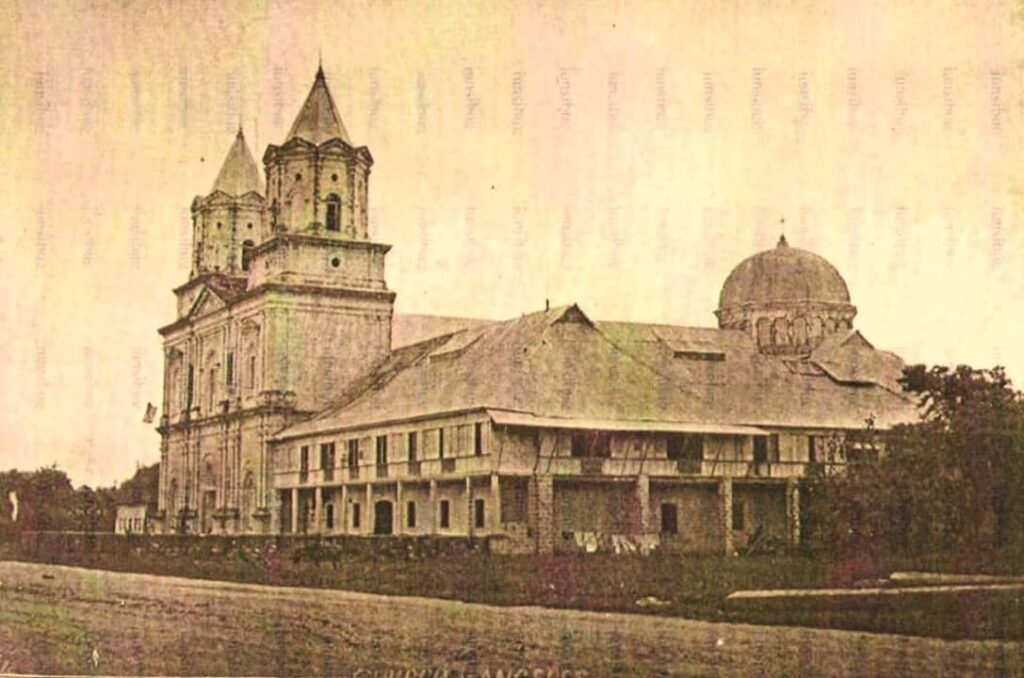
Angeles Cathedral. It was used as hospital by the American 2nd Division, where sick
and wounded were put inside the church premises. On October 16, 1899, the guns of
Filipino Corps of Artillery led by Colonel Ladislao Jose, fired on the church to signal
the general attack on the Americans in Angeles.
THE FILIPINO GENERAL OFFENSIVE; OCTOBER 10-20, 1899
The town of Angeles, occupied by General MacArthur’s 2nd Division, was encircled to the west by the Mascardo Brigade, to the front along the railroad, with the brigade of San Miguel, and to the east by the Aquino Brigade. From October 10 to 20, Filipino forces under the brigades and auxiliary units of Colonel Queri, Major Reyes (Zambales Battalion), and the Kawit Battalion participated in the general attack on the American line defending Angeles. A unique in the strategy of war employed by the Filipinos during the attack by Filipinos on the Americans was the employment of night attacks (11 consecutive nights), and the extensive use of modern artillery of the Philippine Corps of Artillery.
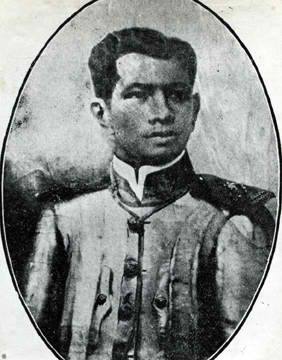
brigade of General San Miguel during
the major offensive on October 16, 1899.
Elements of Mascardo Brigade fought from the west, around the town to the Porac-Angeles road while the Aquino Brigade made offensives from the east in Magalang road. The field commander of the Philippine Corps of Artillery, Major Badell, with Colonel Ladislao Jose, posted the modern field guns and auto0matic guns near Abacan, along the main front with the San Miguel Brigade, including the Hotchkiss, Maxim-Nordenfeldt, and the Colt automatic gun. It is probable that there were artillery duels between American and Filipino artillery forces during the second battle of Angeles. The Americans were amazed with the Filipinos having modern artillery, especially the Hotchkiss field gun. The Filipino infantry night attacks mostly commenced around 2.30 a.m. to 4 a.m., at times continued until daylight.
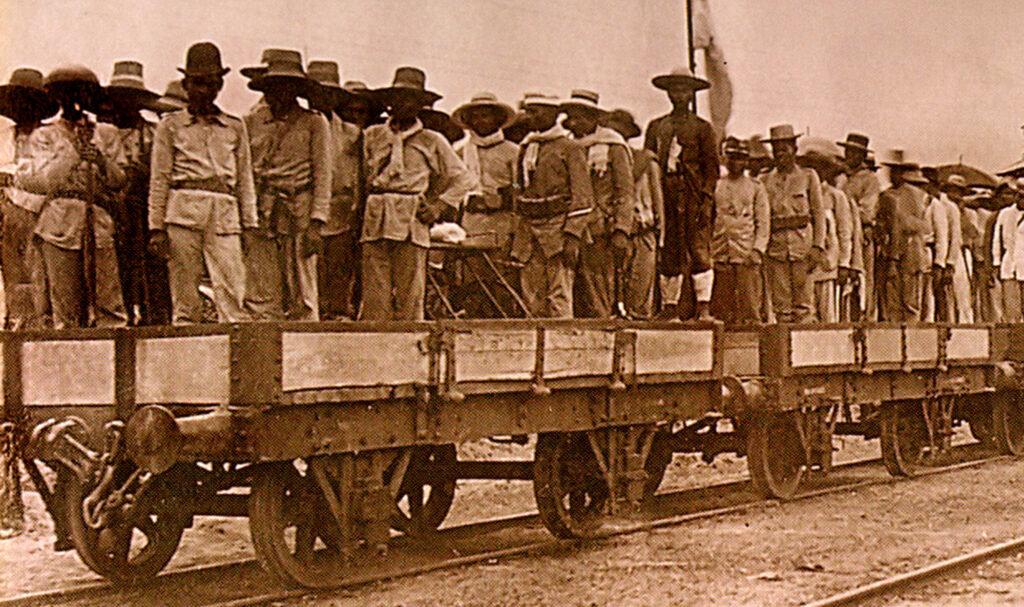
front between the Filipino and American forces, the San Miguel Brigade had borne the
brunt of the general attack on the American 1st Brigade, while to the right, the Aquino
Brigade, provided the Torres Bugallon and Dayrit Column and attack the American 17th US
Infantry lines during the general offensive on October 16, 18999.
THE OCTOBER 11 AND 16 MAIN ATTACK
In one of the most highlight of the general offensive at Angeles, the October 16, 1899 was the most severe to be made by the Philippine Division, as described by General Wheeler (1st Brigade), “the attacks commencing after midnight on the morning of the 11th and 16th being more severe than the majority of the engagements in the island”. The Attack on October 16 was actually the most crucial and serious being felt by the Americans. In an unorthodox way the Filipino employed against the Americans at the Battle of Angeles, Major Badell of the Artillery Corps gave the signal at 2.30 a.m. to fire the field artillery guns on the Angeles Cathedral as the sign of the commencement of the general offensive. Elements of the Lacuna Column crossed the Abacan River towards the 12th and 9th US Infantry outposts along the riverbanks, firing on the American troops until 3.45 a.m.
The Kawin Battalion under Major Bonzon advance from the left, penetrating American line at the barrio Pandan, burning houses and barracks that housed American troops. Colonel Ladislao Jose of the Corps of Artillery fired several shots of its artillery on the American positions near the railroad bridge, covering the advance of advance of Filipino infantry on American line led by Major Reyes. Major Badell, with his detached artillery unit with 25-mm Nordenfelt guns, conducted counter-fire on the American positions at the barrio of Pampang.
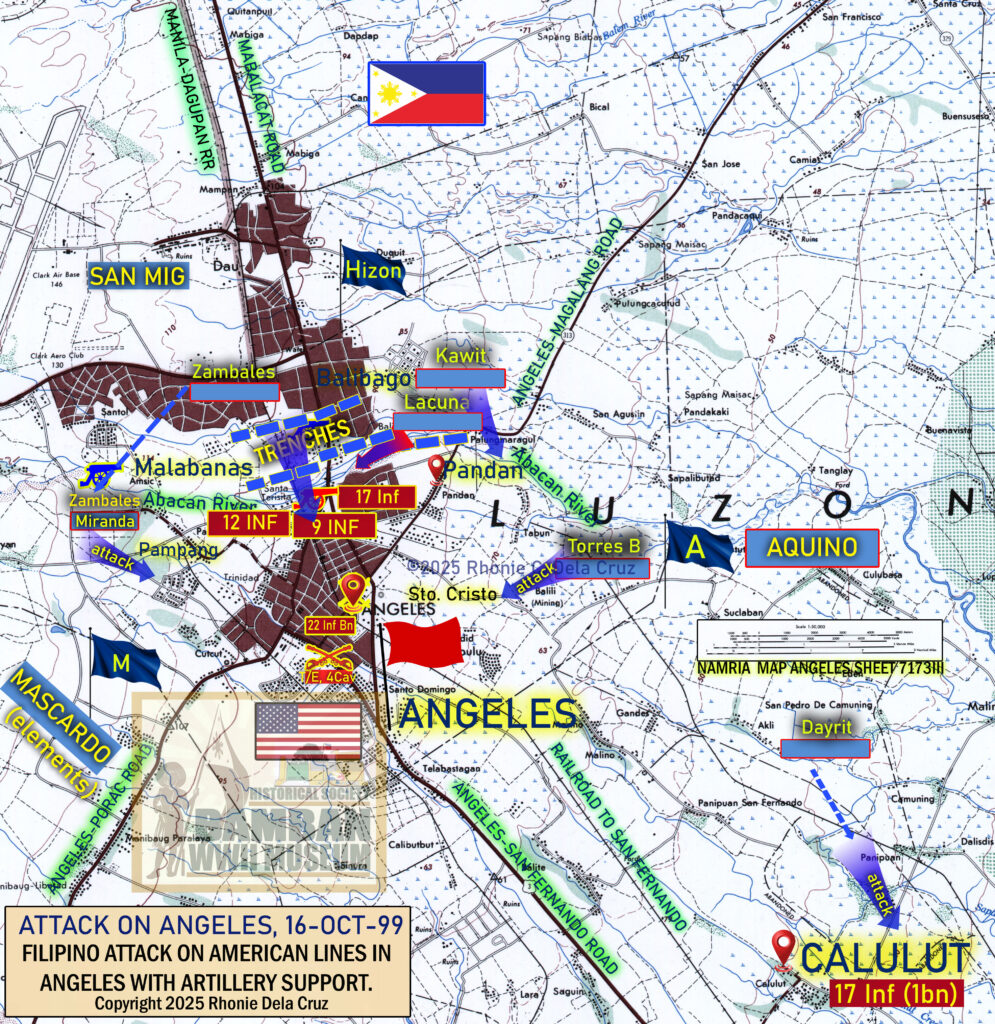
with the Filipino brigades, battalions and flying columns from both the San Miguel Brigade
and the Aquino Brigade conducting the general offensive. The San Miguel Brigde, with its
Zambales, Kawit Battalions and the Lacuna Column (Gapan Volunteers) were commanded
by General Maximino Hizon.
Map copyright by Rhonie Dela Cruz
The Aquino Brigade, in general support of the attack, provided 1 company of the Torres Bugallon Battalion during the attack on the barrio of Sto. Cristo before dawn, while 2 companies of the Dayrit Flying Column attacked 17th US Infantry positions in the direction of barrio Calulut, an important encampment of the O’Brien Battalion. The 2 battalions of the 17th US Infantry, along with the 3 battalions of the 9th and 12th US Infantry, with the artillery support of the Hotchkiss M1897 3.2-inch gun from Light Battery E, 1st US Artillery and the 3-inch Hotchkiss naval gun and Gatling gun of the armored car, made a stand and were able to repulse the Filipino offensive, keeping the town center of Angeles from being captured.
The general offensive at Angeles by Filipino forces, although unsuccessful, was a coordinated attack with large number of commands including the Kawit Battalion, Torres Bugallon battalion, Lacuna Column, the Gapan Volunteers and the Corps of Artillery, with the general support of the 3 brigades of Generals Aquino, San Miguel, and Mascardo. Aside from the use of modern artillery field guns and automatic guns that were reserved only to the Americans, the Filipinos made use of these guns similar to the Americans used in combat; the Hotchkiss revolving cannon and the Colt automatic gun. In addition, the Filipino troops enjoyed ample supply of ammunitions during the offensive, as observed by General Joseph Wheeler of the 1st US Brigade;
“The enemy was very lavish in the expenditure of ammunition. As far as I could learn all officers on the line reported the insurgent fire as very much greater than ours, and officers at other points on the line estimated the volume of the enemy’s fire at three or four times ours.”
General Joseph Wheeler
October 16, 1899 at Angeles
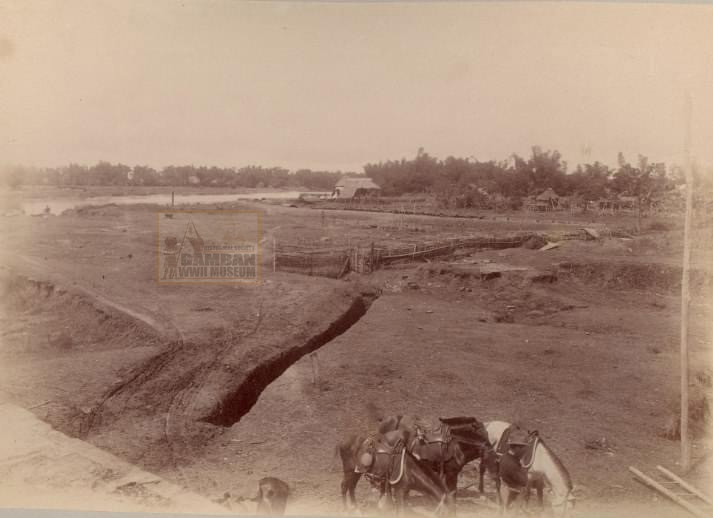
bamboo thickets, fortified with series of trenches in what is now the area of Balibago and
Malabanas, the Filipino soldiers from the Kawit, Zambales Battalions and the Gapan Volunteers
had withstood the American attacks on September 28, 1899 and made their gallant attacks on
the American outposts and lines defended by the 9th US Infantry in October 1899 during the
Second Battle of Angeles: a forgotten history in the town of Angeles.
The Battle of the Angeles, as a Filipino offensive, is another example of forgotten war, that many Kapampangan may not even aware of. The period October 10-20, 1899 was a testament to the fighting abilities of our Filipino forces that should be remembered as we fought for freedom, as people and as a nation. It is sad that the important historical accounts of the battles at Angeles are not even remembered. I hope that by writing this article, it may serve to remind us of the sacrifices and bravery of our people during the Philippine-American War at Angeles, and to all forgotten places of battles.
Copyright 2025 Rhonie Dela Cruz
Bamban Historical Society
Bamban WWII Museum
Provincial Government of Tarlac –
Tarlac Provincial Tourism Office
CITATIONS
(1) MacArthur, Arthur (Major-General). Report of Operations of the Second Division, Eight Army Corps, Annual Reports of the War Department for the Fiscal Year Ended June 1900.
(2) Annual Reports of the War Department for Fiscal Year Ending June 30, 1900.
(3) The Philippine Insurrection Against the United States Volume IV.
